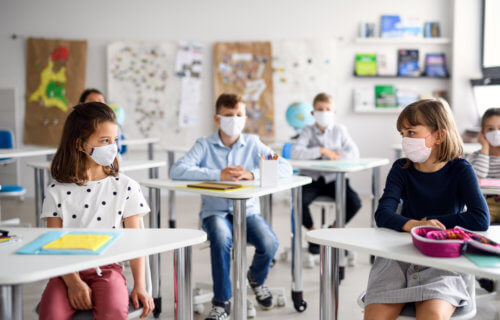BOSTON, Mass. — Mask mandates are ending all across the United States as COVID-19 slowly becomes less threatening. However, a new study warns it’s still soon to drop these strict guidelines in schools.
Scientists from the Harvard T.H. Chan School of Public Health and Massachusetts General Hospital (MGH) report ending mask policies now would put school staff, students, and parents at increased risk of COVID-19 infection. They believe local COVID infection rates across the country need to be much lower before schools even consider lifting mask mandates.
“It is critical that communities have a conversation about their goals for in-school mitigation measures,” explains senior study author Andrea Ciaranello, MD, an investigator in the department of Infectious Diseases at MGH, in a university release. “Do they want to prevent all in-school transmissions? Or do they want to keep the number of cases among students, staff, and families low enough that no one is likely to be hospitalized? Or do they want to minimize absences due to isolation and quarantine so students could take advantage of in-person learning, a goal which also requires keeping overall cases low? These are all valid goals, and once they are clearly articulated, we can use a systematic, mathematical approach to estimate the level of mitigation needed to meet them.”
Where does the infection rate need to be?
According to the National Center for Education Statistics, roughly 37 million children currently attend elementary school in the United States. Despite young students making up such a sizable portion of the U.S. population, study authors claim administrators in charge of these schools have been provided with little guidance on when to lift or change mask policies throughout the pandemic.
Researchers used a series of model-based simulations to estimate how changes in mask policies may influence infection rates among teachers, students, school staff, and parents. In general, that analysis concluded the “best time” to either end or reinstate a mask policy really depends on the goals of a particular school’s leaders. Still, the research team concludes that if an elementary school wants to maintain a reasonably safe environment for everyone, now is not the time to be lifting mask mandates. Local case rates across the nation should drop considerably before that happens.
For instance, let’s say about 25 percent of the students and 70 percent of teachers at a school have their COVID-19 vaccinations. In that scenario, if school administrators want to limit the amount of new monthly infections to under 10, they should only end mask policies once local case rates dip below 14 cases per 100,000 people each day.
Alternatively, if 90 percent of a school’s teachers and students receive the vaccine, that same goal is reachable by ending mask policies even when the local case rate is higher than 50 cases per 100,000 per day.
What about new variants?
Researchers also note that a number of additional factors can influence these calculations, such as vaccination rates and whether or not a school implements regular COVID testing on-site. This study focused on the Delta variant, but study authors are confident their work applies to other variants as well.
“This study emphasizes that it is important for schools to set clear objectives for what they want to achieve from their policies around masks and other mitigation measures,” concludes lead study author John Giardina, a PhD candidate in health policy in the Center for Health Decision Science at Harvard Chan School. “Having data-driven metrics about when we want to take off masks or add them back on can help clarify the decision-making process, and make sure policy decisions both align with the goals of a community and are responsive to the ever-shifting dynamics of this pandemic.”
The team published their findings in JAMA Network Open.
